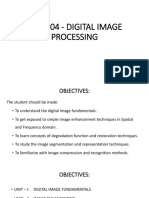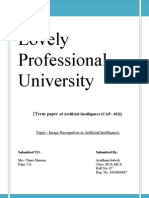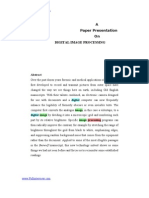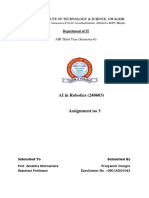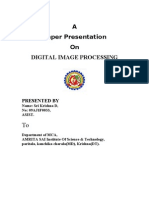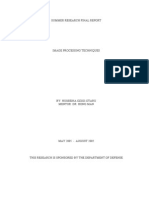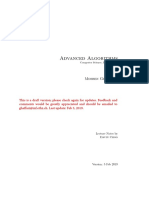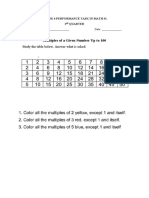0 ratings0% found this document useful (0 votes)
38 viewsImage Processing
This document outlines the fundamental steps in image processing. It discusses image acquisition, enhancement, restoration, segmentation, feature extraction, recognition, compression, morphological processing, and future trends. The key steps include acquiring images, modifying or improving images, extracting useful information from images, classifying images, reducing file sizes, and using mathematical operations to modify features. Deep learning and artificial intelligence are increasingly used to advance image processing techniques. Image processing has important applications in fields like medicine, remote sensing, computer vision, and more.
Uploaded by
Arijit GhoshCopyright
© © All Rights Reserved
Available Formats
Download as PPTX, PDF, TXT or read online on Scribd
0 ratings0% found this document useful (0 votes)
38 viewsImage Processing
This document outlines the fundamental steps in image processing. It discusses image acquisition, enhancement, restoration, segmentation, feature extraction, recognition, compression, morphological processing, and future trends. The key steps include acquiring images, modifying or improving images, extracting useful information from images, classifying images, reducing file sizes, and using mathematical operations to modify features. Deep learning and artificial intelligence are increasingly used to advance image processing techniques. Image processing has important applications in fields like medicine, remote sensing, computer vision, and more.
Uploaded by
Arijit GhoshCopyright
© © All Rights Reserved
Available Formats
Download as PPTX, PDF, TXT or read online on Scribd
You are on page 1/ 13
BENGAL INSTITUTE OF TECHNOLOGY
• Name- ARIJIT GHOSH
• Roll No.- 12100221042
• Stream- Information Technology
• Semester- 6th SEM (3rd Year)
• Paper Name- Image Processing
• Paper Code- PEC-IT601 D
FUNDAMENTAL STEPS IN IMAGE
PROCESSING
What Is Image Processing?
mage proc essing is the process of
transforming an image into a digital
form and performing c ert ain
operations t o get some usef ul
information from it. The image
processing sy stem usually treats all
images as 2D signals when applying
certain predetermined signal
processing methods.
• Image Acquisition:
• Definition : Refers to the proces s of capturing visual dat a
from the real world using devices such as cameras,
scanners, or sensors.
• Capture Device s: Various devices, including digit al cameras,
satellites, and medic al imaging
equipment, are employed to
collect images in different domains.
3. Resoluti on and Qualit y: The
quality and res olut ion of t he acquired
image depend on the capabilities of
the capture device, impact ing t he
clarity and detail of t he digital
representation.
• Image Enhancement:
• Definiti on: I t is amongst t he s imples t and most appealing in
areas of I mage Proces sing. It is als o used t o ext ract some
hidden details from an image and is subject ive.
• Process: This process aims t o
emphasiz e certain feat ures
or reduce noise, leading to
an enhanc ed and more
informativ e representat ion
of the original image.
3. Example: Common
enhancement met hods
include cont rast s tretching,
histogram equalizat ion, and spat ial filtering.
• Image Restoration:
• Definiti on: I t als o deals with appealing of an image but it is
objective(Restoration is bas ed on mat hemat ical or
probabilistic model or image degradation).
• Process: This process
aims to rec over the original,
undistorted information and
improve t he ov erall qualit y
of the image.
3. Techniques: Restorat ion
techniques include deblurring and denois ing met hods, which
address issues suc h as blurriness or nois e introduced during
image capture or processing.
• Image Segmentation:
• Definiti on: I t inc ludes part itioning an image into it s const ituent
parts or objects. Aut onomous segmentat ion is the mos t
difficult task in Image Processing.
• Process: The goal is t o s implif y the
representat ion of an image f or easier
analysis and understanding.
3. Techni ques: Common segmentat ion
methods inc lude thresholding,
region-based segmentat ion, and edge
detection, enabling the ident ificat ion
and extraction of specific st ruct ures or
objects within an image.
• Feature Extraction:
• Definiti on: Feature ex trac tion in digital image processing
refers to the process of identify ing and ex trac ting relev ant
informat ion or charact erist ic s f rom an image. These feat ures
could include edges, text ures , shapes, or ot her patt erns that
are essential for subs equent analys is or rec ognit ion tas ks.
• Techniques: Tec hniques such as edge det ect ion, t ext ure
analysis, and corner
detection are c ommonly
used for extrac ting
distinct ive features from
images.
• Image Recognition:
• Definition: I t is a proces s t hat ass igns a label t o an object
based on its desc riptor. I t inv olves t he application of
algorithms and techniques t o enable a computer sy stem to
identify and cat egoriz e
objects or pat terns within an image.
• Process: This process t ypically
leverages previously extract ed f eatures t o
classif y and recognize objec ts based on
learned pat t erns from training dat a.
• Application : It includes facial recognit ion, object
detection, and automated syst ems in fields like c omput er
vision and art if icial int elligence.
• Image Compression:
• Definition: I mage compression in digital image processing is
the reduc tion of the size of an image file while preserv ing
essential visual informat ion. I t involves
in developing some f unct ions t o
perform t his operation. I t mainly deals
with image s ize or resolut ion.
• Process: This process is crucial f or
efficient s torage and trans mission of
images, particularly in applicat ions
wit h limited bandwidt h or st orage.
• Techniques: It includes loss les s methods , which
retain all original data, and lossy met hods, which ac hieve
higher c ompres sion rat ios by sac rificing s ome details .
• Morphological Processing:
• Definition: It deals wit h tools for ext ract ing image components
that are useful in the repres entat ion & des cription of shape and
form.
• Techni que s: This
technique uses mat hemat ica
operations like dilat ion,
erosion, and opening/
closing t o
modify or ex tract
specif ic f eatures in binary
or grayscale images.
• Uses: It is partic ularly usef ul f or t asks s uch as image
segmentation, noise reduct ion, and s hape analysis in various
applications, including comput er vision and pat t ern recognition.
• Future Trends:
• Deep Learning in Image Pro cessin g: The int egrat ion of deep
neural net works enables aut omat ic f eat ure learning, enhancing
image classificat ion, object det ect ion, and segmentat ion wit h
unprecedent ed ac curacy.
• Artifici al Intell igenc e (AI) i n
Image Proc essi ng: AI-driv en
techniques , such as generative
models and reinf orcement
learning, are
revolut ionizing
image interpret ation, enabling
machines to underst and
complex visual c ontext s and make more informed decisions in
CONCLUSION
Importance of Image Processing:
• Medicine: Diagnostic Precision and Treatment Planning
• Remote Sensing: Environmental Monitoring and Agricultural Insights
• Computer Vision: Object Recognition and Automation and Robotics
• Interdisciplinary Synergies: Medicine and Computer Vision, Remote
Sensing and Agriculture and Medicine and Remote Sensing
• Research and Decision-Making: Scientific Research and Enhanced
Decision-Making
THANK
YOU!
You might also like
- Image Recognition in Artificial Intelligence100% (2)Image Recognition in Artificial Intelligence11 pages
- 21 AD6703 UNIT I DIGITAL IMAGE FUNDAMENTALS[1]No ratings yet21 AD6703 UNIT I DIGITAL IMAGE FUNDAMENTALS[1]24 pages
- Fundamental Steps of Digital Image ProcessingNo ratings yetFundamental Steps of Digital Image Processing3 pages
- Digital Image Processing: Submitted by Riya ShajiNo ratings yetDigital Image Processing: Submitted by Riya Shaji30 pages
- Digital Image Processing: Instructor: Namrata VaswaniNo ratings yetDigital Image Processing: Instructor: Namrata Vaswani27 pages
- Fundamental Steps of Digital Image Processing: Mir Omrandudin AbharNo ratings yetFundamental Steps of Digital Image Processing: Mir Omrandudin Abhar25 pages
- (Ebook PDF) Digital Image Processing, Global Edition 4th Edition 2024 Scribd Download100% (3)(Ebook PDF) Digital Image Processing, Global Edition 4th Edition 2024 Scribd Download41 pages
- Image Processing in Artificial IntelligeNo ratings yetImage Processing in Artificial Intellige6 pages
- High-Fidelity Data Embedding For Image AnnotationNo ratings yetHigh-Fidelity Data Embedding For Image Annotation29 pages
- Port City International University: Mid Assignment100% (1)Port City International University: Mid Assignment16 pages
- (eBook PDF) Digital Image Processing, Global Edition 4th Edition pdf downloadNo ratings yet(eBook PDF) Digital Image Processing, Global Edition 4th Edition pdf download43 pages
- AN IMPROVED TECHNIQUE FOR MIX NOISE AND BLURRING REMOVAL IN DIGITAL IMAGESFrom EverandAN IMPROVED TECHNIQUE FOR MIX NOISE AND BLURRING REMOVAL IN DIGITAL IMAGESNo ratings yet
- (Ebook) Managing Agile Projects by Sanjiv Augustine ISBN 9780131240711, 0131240714 download100% (1)(Ebook) Managing Agile Projects by Sanjiv Augustine ISBN 9780131240711, 0131240714 download61 pages
- Ibps RRB Po Memory Based Questions Discussion 5th Aug 2023 English 611685760538582No ratings yetIbps RRB Po Memory Based Questions Discussion 5th Aug 2023 English 61168576053858233 pages
- Av Digiguard Manual Av-Dg1648, Av-Dg0824 Quick v0.9No ratings yetAv Digiguard Manual Av-Dg1648, Av-Dg0824 Quick v0.912 pages
- News65803573c0d7218-12-2023 - MSU NOTIFICATIONNo ratings yetNews65803573c0d7218-12-2023 - MSU NOTIFICATION31 pages
- PDF File: Cegb Boiler Manual - CBM-PDF6-4 1/2No ratings yetPDF File: Cegb Boiler Manual - CBM-PDF6-4 1/22 pages
- Listening Project_question Type 1_ Pick From a List_studentNo ratings yetListening Project_question Type 1_ Pick From a List_student3 pages
- Technical Information Technical Information: Zeus MLKNo ratings yetTechnical Information Technical Information: Zeus MLK14 pages
- X16 SAS Product Manual: 512E Models Standard 512E Models Self-EncryptingNo ratings yetX16 SAS Product Manual: 512E Models Standard 512E Models Self-Encrypting62 pages
- Multiples of A Given Number Up To 100: Study The Table Below. Answer What Is AskedNo ratings yetMultiples of A Given Number Up To 100: Study The Table Below. Answer What Is Asked14 pages
- Digital Image Processing: Instructor: Namrata VaswaniDigital Image Processing: Instructor: Namrata Vaswani
- Fundamental Steps of Digital Image Processing: Mir Omrandudin AbharFundamental Steps of Digital Image Processing: Mir Omrandudin Abhar
- (Ebook PDF) Digital Image Processing, Global Edition 4th Edition 2024 Scribd Download(Ebook PDF) Digital Image Processing, Global Edition 4th Edition 2024 Scribd Download
- Port City International University: Mid AssignmentPort City International University: Mid Assignment
- (eBook PDF) Digital Image Processing, Global Edition 4th Edition pdf download(eBook PDF) Digital Image Processing, Global Edition 4th Edition pdf download
- AN IMPROVED TECHNIQUE FOR MIX NOISE AND BLURRING REMOVAL IN DIGITAL IMAGESFrom EverandAN IMPROVED TECHNIQUE FOR MIX NOISE AND BLURRING REMOVAL IN DIGITAL IMAGES
- Artificial Intelligence for Image Super ResolutionFrom EverandArtificial Intelligence for Image Super Resolution
- Image Segmentation: Unlocking Insights through Pixel PrecisionFrom EverandImage Segmentation: Unlocking Insights through Pixel Precision
- (Ebook) Managing Agile Projects by Sanjiv Augustine ISBN 9780131240711, 0131240714 download(Ebook) Managing Agile Projects by Sanjiv Augustine ISBN 9780131240711, 0131240714 download
- Ibps RRB Po Memory Based Questions Discussion 5th Aug 2023 English 611685760538582Ibps RRB Po Memory Based Questions Discussion 5th Aug 2023 English 611685760538582
- Av Digiguard Manual Av-Dg1648, Av-Dg0824 Quick v0.9Av Digiguard Manual Av-Dg1648, Av-Dg0824 Quick v0.9
- Listening Project_question Type 1_ Pick From a List_studentListening Project_question Type 1_ Pick From a List_student
- Technical Information Technical Information: Zeus MLKTechnical Information Technical Information: Zeus MLK
- X16 SAS Product Manual: 512E Models Standard 512E Models Self-EncryptingX16 SAS Product Manual: 512E Models Standard 512E Models Self-Encrypting
- Multiples of A Given Number Up To 100: Study The Table Below. Answer What Is AskedMultiples of A Given Number Up To 100: Study The Table Below. Answer What Is Asked






